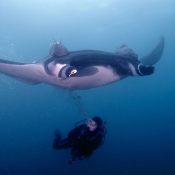The Giant Manta Ray (Manta birostris) is the largest of several species of manta rays throughout the world. They can occasionally be seen here in Florida. The most commonplace to see these elegant swimmers are around coral reefs where smaller fish clean parasites collected on the rays from open waters.
Recently, an endangered species petition was proposed for three species of manta rays, including the Giant Manta Ray. Threats from illegal fishing in several countries have caused their populations to decline rapidly. They also have low reproductive rates at one pup every two years. They give live birth, but once the pup is born, there is no parental care, which reduces survival rates.
Their diet consists of plankton and very small fish. As they swim, food and oxygen from the water are filtered continuously. There is no umbilical cord, so the pups have to rely on another way of getting oxygen before they enter open waters where they can swim. They do this the same way some sharks do when they rest. It’s called buccal pumping. A small part inside their mouth pushes fluid into the mouth and past the gills. Think of it like a person gulping. Once they are born, they use a process called ram ventilation. This just means as they swim, the water passes through their gills.
Manta ray mating is really weird. It usually occurs at the reef cleaning stations. Females will release a sex hormone when they want to mate, and several males will line up to mate with her. This is referred to as “train mating” and increases the odds of fertilization.
Many places have already implemented protection for Manta Rays. Here in Florida, it is illegal to kill them under FL Administrative Code 68B-44.008. This protection has benefited not only the rays themselves but also the economy of many regions. The top 10 hot spots for giant manta rays bring in an average of $73 million in direct funds and $173 million in indirect funds. However, many areas have had such a high interest in manta rays that regulations had to be put in place so as not to disturb them.
If you are lucky enough to see one of these graceful giants here in Florida please, respect their space, don’t try to pet them, and keep your distance. If you witness anyone poaching a manta ray, you can report it to your local law enforcement or through the FWC Wildlife Alert Reward hotline; 888-404-FWCC (3922).

